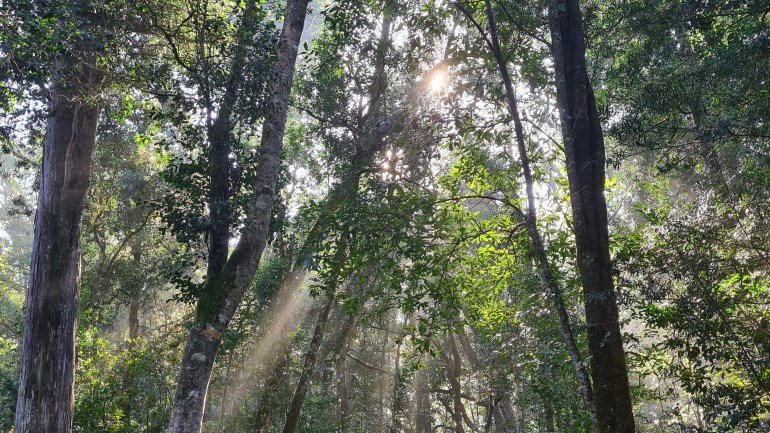It’s 8am on a Tuesday and Rudi Swart, 33, is getting ready for yet another day in the office. After tossing his work bag in his car, he picks up his colleague – experienced rock climber, Matthew Kingma – from his home in the South African town of George. From there it’s a 20-minute drive to the Groenkop Forest parking area, and a 25-minute walk to the 17-metre (55-foot) assegai tree (Curtisia dentata) Swart – who himself measures 1.94 metres (6.36 feet) – will be climbing today.
Before climbing the tree, they need to throw a rope with a weighted end over a suitable branch. This is a frustrating process that can take up to an hour of trying, but today they are in luck: Kingma scores a perfect strike on his fourth attempt. Once the rope is around the branch, they pull it down and use it to take a second rope to the top of the tree. Swart attaches one of the ropes to his harness and climbs the other one, while Kingma waits at the bottom and makes sure his charge cannot fall. “You feel it in the legs, not the arms,” says Swart, with a diffident laugh. “When I started, I was slow. But now I can get up a tree in about 10 minutes.”
After making himself comfortable on a branch with a good view of a clump of the assegai’s small, off-white flowers, Swart gets to work. Over the next four hours he makes a note of every creature that visits the flowers, and he tries to catch at least one sample of each different species. He also takes hourly temperature and wind speed (he brings a portable anemometer up the tree with him!) recordings. Kingma, meanwhile, sits on the forest floor and waits …
![Rudi Swart climbs a tree in the Groenkop Forest, South Africa [Courtesy of Rudi Swart]](https://www.occasionaldigest.com/wp-content/uploads/2024/12/IMG_5592-1732375826.jpg)
The next day, weather permitting, they will do it all again. Because when you’re part of a tiny band of people who are trying to understand the secret world above our heads, there is little time to waste. Despite being priceless biodiversity hotspots and carbon sinks, Africa’s Indigenous forests remain one of the most poorly understood biomes in the world.
All told, Swart did 36 climbs (24 diurnal and 12 nocturnal) up 24 different individual trees of six common species in Groenkop. Across 144 observation hours, over a four-month period between September 2021 and January 2022, he recorded 105 different insects and invertebrates. Of these, two new hoverflies have been formally described by John Midgley, a hoverfly expert based at the KwaZulu-Natal Museum. It’s hard to say how many more undescribed species Swart may have found: identifying new species and working out how they fit into the ecosystem is both expensive and time-consuming. That’s why, globally, only 10-20 percent of insects have been described.
“When you walk through a forest, it’s dark and cool and you don’t actually see that much life,” says Swart. “But up in the canopy it’s a completely different story. It’s bright and sunny and completely alive.”
Charles Haddad, 45, a spider expert and prolific author of scientific papers from the University of the Free State, agrees: “Knowing what’s happening near the ground is one thing,” he says. “But large trees flower at the top. If you want to have a clue what’s pollinating these trees you have to look at what’s going on up there.”
Haddad has used canopy fogging – a method pioneered by entomologist and visionary biodiversity researcher Terry Erwin in the 1970s that uses targeted poisons to kill the critters living in a single tree – to identify six novel species of jumping spider (across three genera) at Hogsback, some 450km (280 miles) east of Groenkop. He has also identified five new species of ant-like sac spiders and seven new species of dark sac spiders while fogging in Ndumo Game Reserve, near the South Africa-Mozambique border.
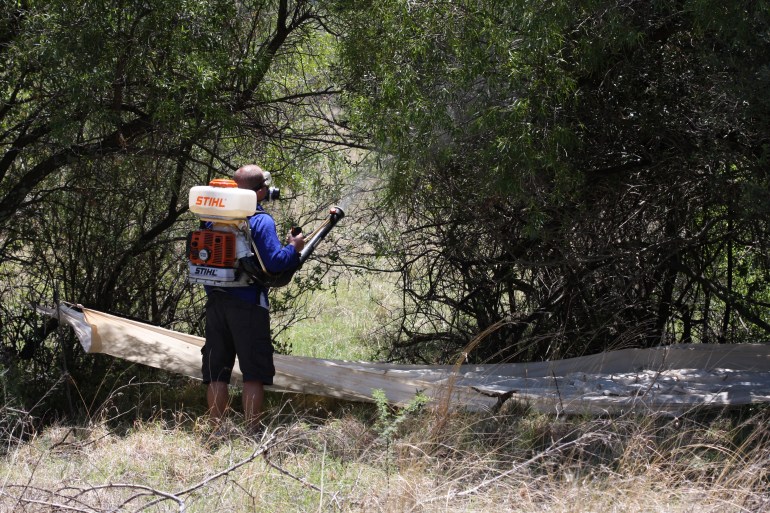
‘We know more about the surface of the moon’
Groenkop is one of many pockets of Indigenous forest scattered across the African continent, from Cape Town in the south all the way up to Benin in West Africa.
Erwin famously described forest canopies as “the last biotic frontier”. And nowhere is the phrase more apt than in Africa. Cape Town is one of the largest and most developed cities on the continent. But the Indigenous forests on Table Mountain, the massif at the heart of the city, “probably contain loads of species that we know nothing about”, says Swart.
While Indigenous forests cover only 9.1 percent of the continent, they are home to an estimated 80 percent of its terrestrial biodiversity. Afromontane (African mountain) forests in particular are globally unique. They stretch across most of the continent, but pockets are often small and isolated, separated by hundreds of kilometres. The similarities in their tree species have been noted since the time of Darwin: African Yellowwood, Ironwood and Cape Beech are all found from South Africa to Ethiopia. But the more scientists learn about Afromontane forests, the more overlap they see between insect species.
“We know more about the surface of the moon than we do about what goes on up in the trees,” says Swart somewhat rhetorically. One of the main reasons is access. Africa is the only continent without a forest canopy crane (in 2017 there were 22 canopy cranes worldwide), which is a permanent structure that allows easy access to trees on both horizontal and vertical axes. While canopy cranes aren’t perfect – typically rooted to one location – they are by far the easiest way to research forest canopies and have revolutionised forest science everywhere except Africa. One Australian crane has yielded more than 120 scientific papers across a wide range of disciplines. One such study highlighted how plant nectar and honey dew (produced by bugs) sustain ant communities.
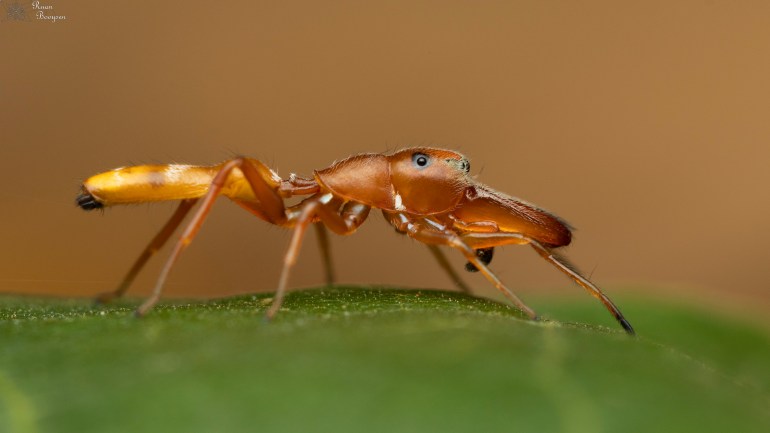
Researchers on the continent do not just have to travel long distances, often on poor roads, to remote patches of forest. They also have to use professional climbing gear to scale trees or employ tactics like baited traps or canopy fogging to collect specimens. The other option is to trudge around on the forest floor and collect stragglers that have come down from the canopy for whatever reason – usually due to a change in weather. (Drones can be used to study the area above the canopy, but they cannot access the canopy itself.)
All of these methods have limitations. Climbing trees requires equipment, skills, fitness and time. Baited traps tend only to attract certain species. And canopy fogging is relatively expensive (the equipment costs about $500 and pesticides cost $50 per tree) and not very easy to get right. There’s also a moral obligation to catalogue every critter you kill, says Haddad: “Fogging a single tree can keep you busy for six months,” he says, pointing to a mayonnaise jar filled with specimens.
While there are myriad challenges to understanding what goes on in Africa’s forest canopies, there are also plenty of rewards, not least the chance to discover new species. “With enough funding you could make a career out of one tree,” says Swart.
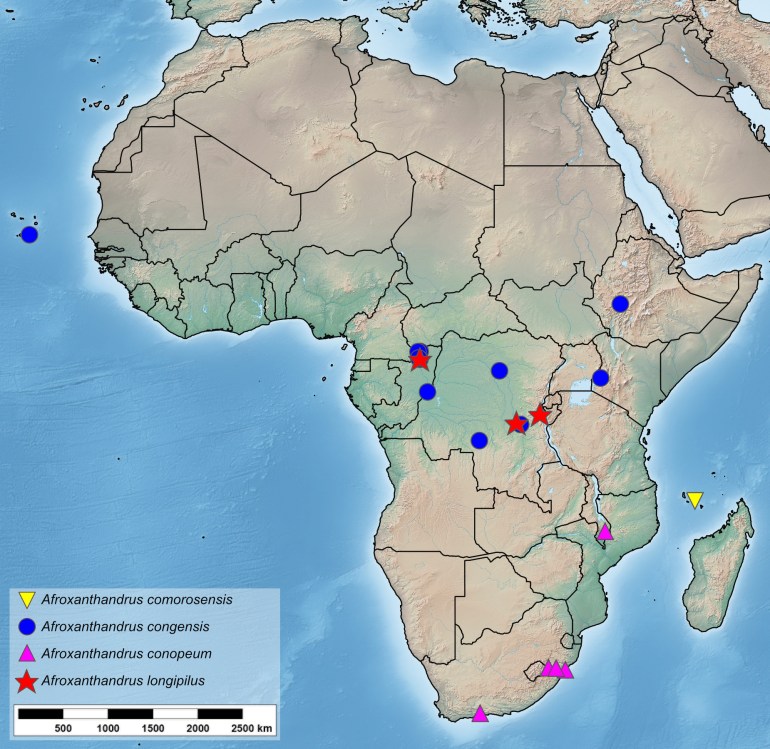
A team effort
With so many trees and so few people willing or able to find out what’s buzzing in their canopies, African scientists are forced to pool resources. Swart’s primary interest, for example, is forest ecology. Specifically, which insects are responsible for pollinating Africa’s great tree species.
To answer these questions, he needs to rely on the expertise of subject matter experts like Midgley, Haddad and many others. It works both ways. Swart helps them in their quest to understand more about their critters of choice.
Whenever Swart catches a hover fly, he sends it off to Midgley. Spiders go to Haddad. Wasps typically go to Simon van Noort at the Iziko Museum in Cape Town. And moths are identified with the help of Hermann Staude, the author of the first field guide to moths in South Africa.
Haddad and Midgley, meanwhile, share any “bycatch” from their collecting missions. And this giant game of pass-the-sample extends across Africa and beyond. For example, Massi Virgilio, a fruit fly expert working in the Democratic Republic of the Congo, takes his samples back to his employers at the Royal Museum for Central Africa in Belgium. And then there are Ashley Kirk-Spriggs and Hitoshi Takano (both based at the African Natural History Research Trust museum in the UK), who share samples from their traps in the Republic of the Congo.
Museums around the world also contain at least 100 million samples collected by colonial-era scientists over the centuries.
“Most museums are willing to share,” says Midgley, who is 41 and boasts an unruly auburn beard. “It saves us having to travel so much, and the motivation for them is that they can get their stuff identified.”
At least that is theory. Midgley points towards a wooden chest of 10 tiny drawers in the corner of his office. Each drawer contains a different group of insects: flies, cicadas, hangingflies… “That is my cabinet of shame,” he says with a laugh. “It’s filled with stuff I haven’t got around to. Entomologists have so much to do.”
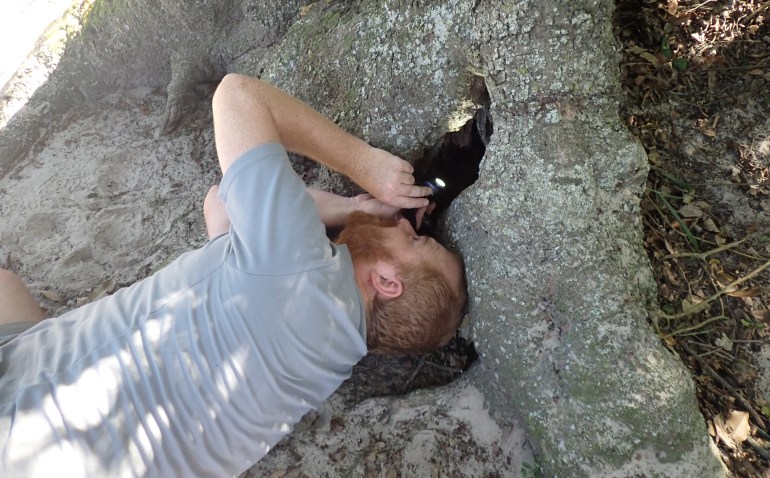
Filling in the blanks
Midgley has catalogued 25 different species of hoverfly in his own garden, including at least one undescribed species. “You and your readers will definitely have seen hoverflies,” he says. “But you may have confused them for a bee or a wasp.” While the individual species are fascinating, he’s more concerned with understanding “why we are finding them where we find them”. This is partially geographic (how far north, how far south), he says, “but then you have to look finer … Forest canopy is one factor.”
The two genera of hoverfly he has worked on most recently always occur in forests. One of these genera is found from George (where Swart is based) to Cape Verde, an island nation off the west coast of Africa. The second genus has a slightly smaller range, extending from South Africa to Togo. “These are animals with massive ranges, but we have hardly any specimens for them,” says Midgley.
The reason for this is simple. The creatures live in the canopy, out of sight of all but the most intrepid researchers. While it’s still very early days, the growth of canopy research is helping to answer some fascinating and important questions, says Midgley before rattling off a pretty meaningful to-do list:
“Are these forests still connected? Is there genetic exchange taking place at such a great scale? What can the study of their canopies teach us about the palaeohistory of the forests, and of Africa? And what does this mean for the conservation of these very small forest pockets?”
According to the theory of evolution, all species in a genus are descended from a single species. Over millions of years, as individuals in the species encounter new habitats and challenges, new species are formed through a process called natural selection. The more isolated a habitat is from the rest of the species, like on an island, the faster speciation will occur.
Africa’s Indigenous forests are becoming increasingly fragmented – Afromontane forests, for example, have shrunk by 18 percent in the last two decades. While this has reduced connectivity for mammals, it’s less of a problem for flying creatures. As Midgley explains: “Insects move around relatively freely in their patch of forest. Every now and then they decide they want to go somewhere. They fly up into the sky and off they go.”
Flies, for example, have good eyesight and can fly up to 50km (31 miles) a day. This makes it relatively easy for them to move from patch to patch. And they appear to be doing so: Midgley has found a lot of species overlap between sites, some of which are separated by hundreds – in some cases thousands – of kilometres.
Spiders can’t fly, but they can disperse by “ballooning”: spinning a thread and drifting with the wind. While some spider species have ballooned thousands of kilometres, as a means of transport it is rather hit-and-miss. This probably explains why Haddad didn’t find many of the same spider species from his fogging sites at Hogsback and Ndumo.
This is a drastic oversimplification and there are many other reasons for speciation. All spiders are predators, for example, but flies can fill many ecological gaps. It follows that there are approximately three times more described fly species (152,000) in the world than spider species (52,400).
![A female Pherecydes zebra or African wide-eyed crab spider found in the Ndumo Game Reserve, near the South Africa-Mozambique border [Courtesy of Ruan Booysen]](https://www.occasionaldigest.com/wp-content/uploads/2024/12/Pherecydes-zebra-female-Ndumo-GR1-1080p-credit-Ruan-Booysen-1732379509.jpg)
The bigger picture
As fascinating as the world of forest canopies is, why does it matter?
“The simple answer is ‘because destroying the planet would be bad for us’,” says Midgley. “People know that the trees matter, but the trees matter because they support all these species.”
And it works both ways, says Haddad. “These giant trees, which are so important for carbon sequestration, depend on tiny insects for their survival.” The insects don’t just pollinate the trees, adds Swart. “They retain connectivity between the forests and keep ecosystems healthy.”
Cataloguing the secret world above our heads is the first step to conserving this biodiversity, says Midgley: “We need to know what we’ve got. Then we can try to work out how it all fits together.”
“There are still a lot of blank spots on the map,” agrees Haddad. “While there are pockets where we have a lot of material [most of it still waiting to be identified], countries like Angola and Mozambique are very poorly studied. And the canopy is the last spot you look at in a new country…”
It’s a mammoth task ahead, but all the scientists Al Jazeera spoke to seemed undeterred. Midgley is experimenting with artificial baits in a bid to attract hoverflies to bucket traps; Haddad is “frantically trying to describe as many species as possible”; and Swart is working hard to secure funding for Africa’s first canopy crane.
The good news: It is not too late. “We still have forests that are functional,” says Midgley. “We just need to keep looking.”
The only way is up.
